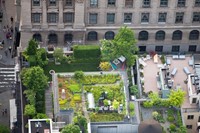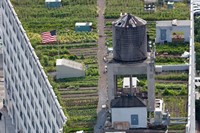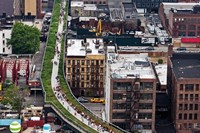New York has long been heralded for its impressive, cloud-scraping skyline but now, in a forthcoming publication by photographer and pilot Alex MacLean, we have the unique chance to view a scarcely documented (but equally fascinating) side to the
New York has long been heralded for its impressive, cloud-scraping skyline but now, in a forthcoming publication by photographer and pilot Alex MacLean, we have the unique chance to view a scarcely documented (but equally fascinating) side to the city: its roofscape. Entitled Up on the Roof: New York’s Hidden Skyline Spaces, the book demonstrates the way in which the flat rooftop, as utilised by New Yorkers, offers a new world of outdoor space and opportunity far above the fast-paced chaos of the city below.
"The flat rooftop, as utilised by New Yorkers, offers a new world of outdoor space and opportunity far above the fast-paced chaos of the city below"
Featured is a brilliant array of images revealing the myriad functions, both public and private, of what MacLean refers to as the “fifth façade". Parasol-wielding sunbathers, swimming pools, tennis courts, restaurants, artworks and private leafy gardens – all captured from MacLean’s low-flying, lightweight plane – are laid bare to the viewer, lying nestled among the chimneys, water tanks and air ducts of a diverse range of structures. What ensues is an enticing and voyeuristically delighting journey across the city’s "aerial oases", rendered to visual perfection through the photographer’s lens.
Although the transformation of rooftops into a “top floor” architectural extension is fairly recent to New York’s history, the concept of roofs as inhabitable spaces is not a novel one. Le Corbusier listed it as one of his five points of modern architecture in his renowned volume Vers une Architecture, published in 1923. In this he stresses that every building, particularly houses, should sport a flat roof including a garden, that way the land occupied by the structure would be reinstated aloft.
MacLean’s images shed light on a similar sense of utopian hope invested in New York’s rooftop havens, both in terms of the “green” mentality of the city (already recognised as the most energy efficient area of the United States) with its plethora of solar panels and white roofs to reflect heat and reduce the need for air conditioning; and the prevailing belief that improved outdoor spaces above lead to more pleasant and livable cities beneath.The city's interesting attempt to undo past environmental wrongdoings in this way rings true throughout the book, providing much (albeit sumptuously presented) food for thought. As Robert Campbell, author of its introduction, expresses, "The images are often unforgettably beautiful, thanks to MacLean's talent as a visual artist. But they're also full of lessons about how we human beings inhabit our earth - and sometimes how we mess it up."
Up on the Roof: New York’s Hidden Skyline Spaces is published by Princeton Architectural Press and is available from May 1.
Text by Daisy Woodward



